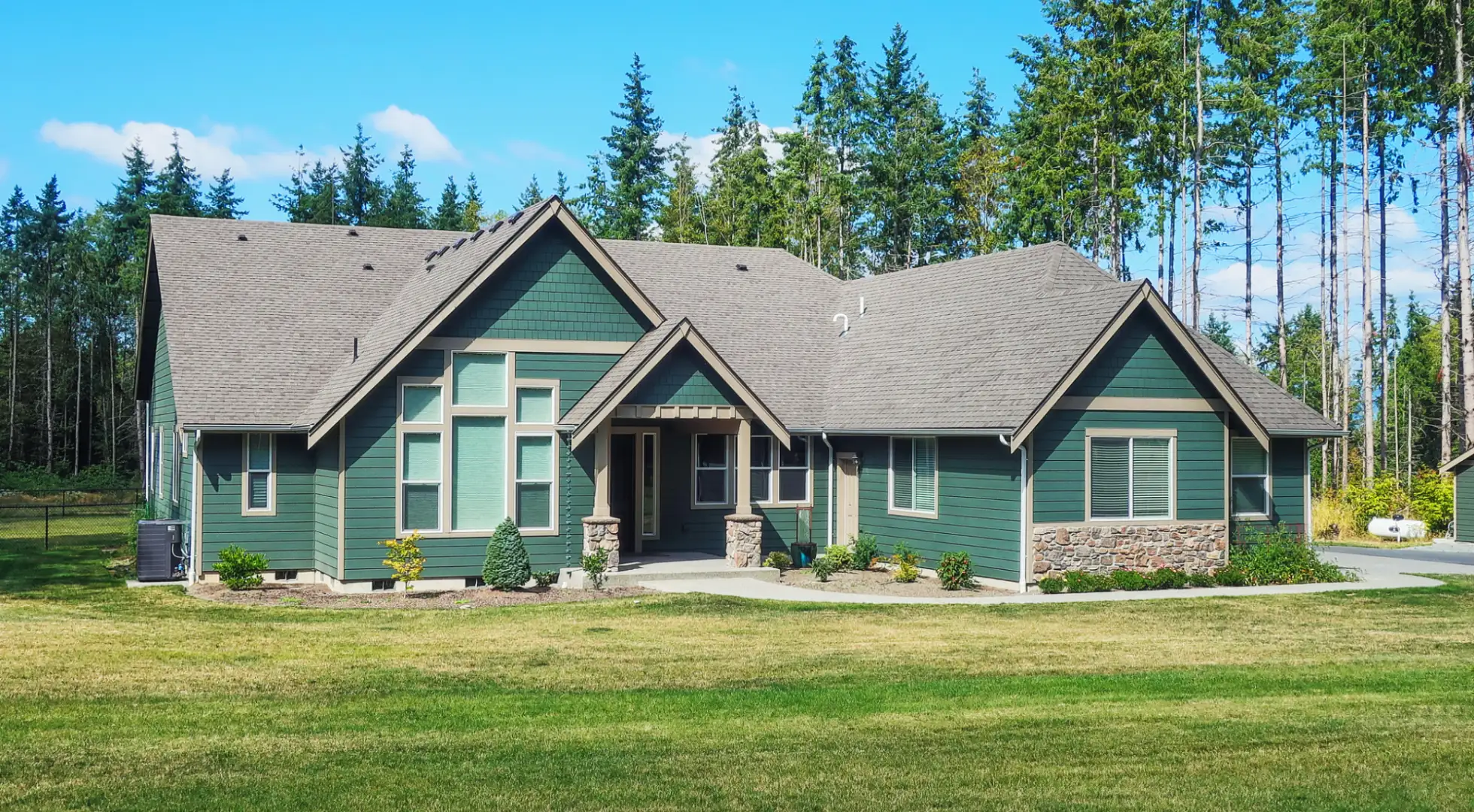What Home Price Can You Get For $2,500 a Month?

You could buy a $320,000 home with an all-inclusive monthly payment of around $2,500. This assumes a 30-year fixed conventional mortgage, 5% down payment, 7.081% interest rate, and includes estimated PMI, taxes, and insurance.
But your results may vary. Several considerations go into calculating the home price you can buy with $2,500 per month, including:
Your interest rate
Your income and debts
Your down payment
Estimating Your Monthly Housing Expense
Many websites take the easy way out and calculate purchasing power based on principal and interest costs alone. In the real world, taxes, insurance, and association dues are typically included in mortgage payments.
Unless otherwise noted, our calculations will be based on the following assumptions:
You’re making a down payment of 5% of the total purchase price
Closing costs are paid separately and do not impact your available funds
Your loan is a 30-year fixed conventional mortgage
Annual taxes equal 1% of the property’s purchase price, divided equally across 12 monthly payments
$125 monthly homeowners insurance premiums
Mortgage insurance premiums based on 760 credit
No homeowner or community association dues
Remember, these figures are just estimates. The actual costs can vary significantly from one property to another. In some scenarios, they could represent a significant portion of your mortgage payment.
How Interest Rates Affect Your Purchasing Power
Few things impact your purchasing power more than the interest rate you qualify for.
Lenders have a myriad of variables that they use to determine your interest rate, but some of the most important include:
Your credit score
Your down payment
Your income and existing debt
As of the time of writing, the average 30-year conventional mortgage rate is 7.081%, according to Mortgage Research Center rate trends found on our homepage. At this rate, based on the assumptions we’ve mentioned, you could buy a $320,000 home with an all-inclusive monthly payment of around $2,500.
But that's just the average rate; if your financial profile is better than most, your rate offers may be lower. Say, for example, you qualify for a rate of 6.5%. In that scenario, a $2,500 monthly payment equals a maximum purchase price of slightly under $335,000.
On the other hand, if your best option is an 8% rate, a $2,500 monthly payment means a maximum home value of around $290,000.
Based on our methodology, here's a quick reference chart of how much home you could get with a $2,500 monthly payment at varying interest rates:
Interest Rate | Maximum Home Price* |
4.0% | $420,000 |
4.5% | $400,000 |
5.0% | $380,000 |
5.5% | $365,000 |
6.0% | $350,000 |
6.5% | $335,000 |
7.0% | $320,000 |
7.5% | $305,000 |
8.0% | $290,000 |
8.5% | $280,000 |
9.0% | $270,000 |
9.5% | $260,000 |
10.0% | $250,000 |
*Maximum home price estimates have been rounded for simplicity.
Your Qualifying Income and Existing Debt
There are two different numbers used to determine your maximum purchasing power: the front-end (housing) DTI and the back-end (total) DTI.
Most conventional lenders allow for a front-end DTI of up to 36% – your total mortgage cost can be up to 36% of your monthly income. To be eligible for a mortgage of $2,500, you must have a monthly qualifying income of around $7,000.
Lenders look for a back-end DTI of 45% or lower. This total DTI includes your mortgage payment and other recurring debt obligations. Some of the common expenses included in the back-end DTI include:
Mortgage Costs
Automotive Loans
Student Debt Payments
Credit Card Minimums
Based on the $7,000 income from the front-end calculation, your total monthly debt could be as high as $3,150, including your mortgage. After subtracting the $2,500 housing payment, you could have existing debts up to $650 per month.
But what if your monthly car payment and credit card minimums total $1,000? Combined with a $2,500 mortgage cost, this total monthly debt obligation of $3,500 would require an income of just over $7,750.
Here's a chart of the maximum front-end (housing) and back-end (total) amounts that you could qualify for based on varying levels of income:
Qualifying Monthly Income | Max House Payment (36%) | Max House + Debt Payments (45%) |
$5,000 | $1,800 | $2,250 |
$6,000 | $2,160 | $2,700 |
$7,000 | $2,520 | $3,150 |
$8,000 | $2,880 | $3,600 |
$9,000 | $3,240 | $4,050 |
$10,000 | $3,600 | $4,500 |
$11,000 | $3,960 | $4,950 |
$12,000 | $4,320 | $5,400 |
$13,000 | $4,680 | $5,850 |
$14,000 | $5,040 | $6,300 |
$15,000 | $5,400 | $6,750 |
Size of Your Down Payment
The size of your down payment directly impacts your monthly housing costs because it affects how much of your purchase you need to finance. Plus, putting more down can reduce the rate you pay for mortgage insurance.
Say you are purchasing a $325,000 home at today’s 30-year conventional average of 7.081%. Based on our outlined assumptions, including a 5% down payment, your monthly cost would be $2,565.
But what if you could make a larger down payment? If you had the funds to put 10% down, your monthly cost would drop to $2,425. If you come up with a 20% down payment, that would eliminate the need for mortgage insurance and reduce your monthly total to $2,140.
So, how much could you afford for $2,500 a month by contributing a larger down payment in our scenario?
With a 10% down payment, a $2,500 monthly mortgage would equal a maximum purchase price of $335,000.
With a 15% down payment, a $2,500 monthly mortgage would equal a maximum purchase price of $355,000.
With a 20% down payment, a $2,500 monthly mortgage would equal a maximum purchase price of $380,000.
How to Buy More Home for $2,500 a Month
Looking for ways that you can stretch your monthly payment further? Here are just a handful of the strategies that can help you buy more home with $2,500 per month:
Down Payment Assistance Programs
There are more than 1,600 down payment assistance (DPA) programs in the United States that help homebuyers get more value from their purchase. DPA programs generally require that you meet income limits or be a first-time homebuyer – sometimes even both – although there are some down payment assistance programs with no cap on your earnings.
Lender Discount Points
Most lenders allow you to purchase discount points at closing in exchange for a lower interest rate on your mortgage. Lender discount points typically cost 1% of your loan total and result in a rate reduction of around 0.25%.
Consider Property Taxes and Association Dues
Property tax assessments can change from one area to another, even within the same city. And while many homes aren’t subject to a homeowners association fee, some communities could have dues that rival the cost of a small mortgage.
To get the most bang for your $2,500 per month home budget, look for properties free of – or with minimal – association dues and consider the impact of municipal, school district, and other relevant taxes.
Discover How Much House You Can Afford for $2,500 a Month
The figures in this article should have given you a pretty good idea of how much home you can afford with a budget of $2,500 per month, but everyone’s situation is different. Your purchasing power could be higher or lower depending on your financial profile and homebuying needs.
For the most accurate picture of what price home you can buy with $2,500 a month, check today's rates and apply with a lending professional who can explain your best mortgage options.






